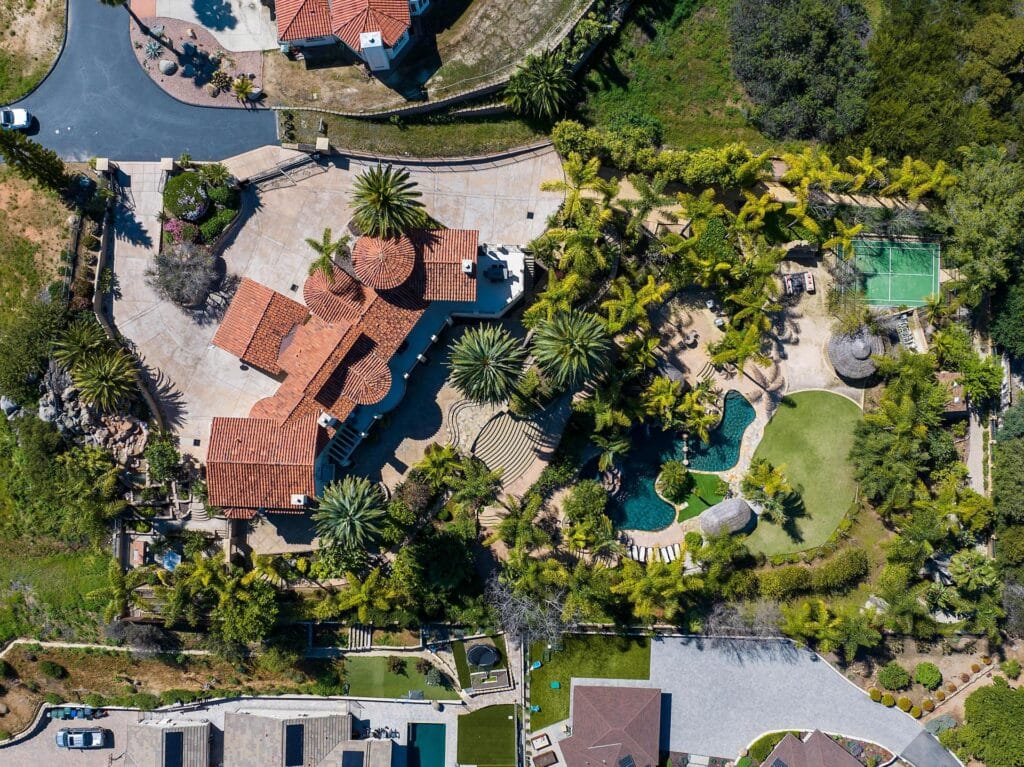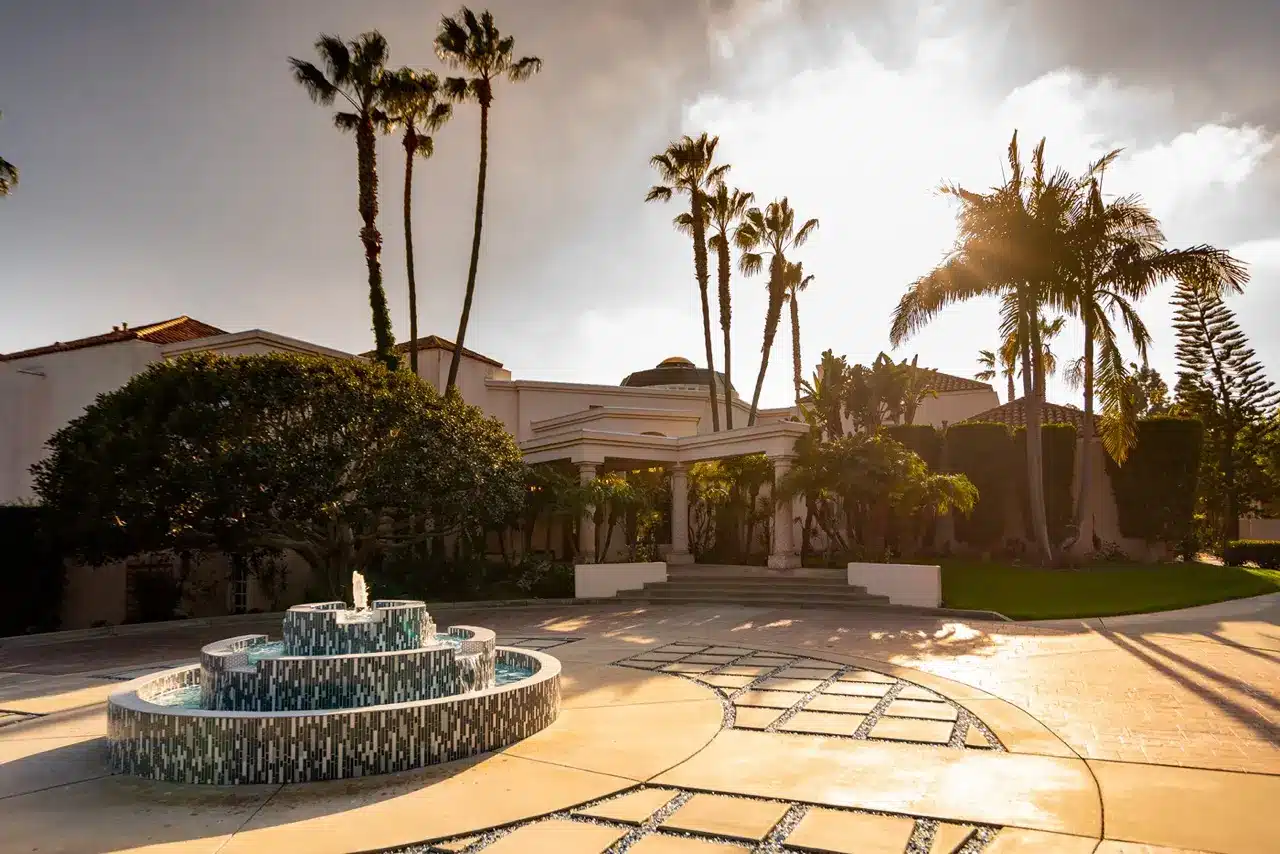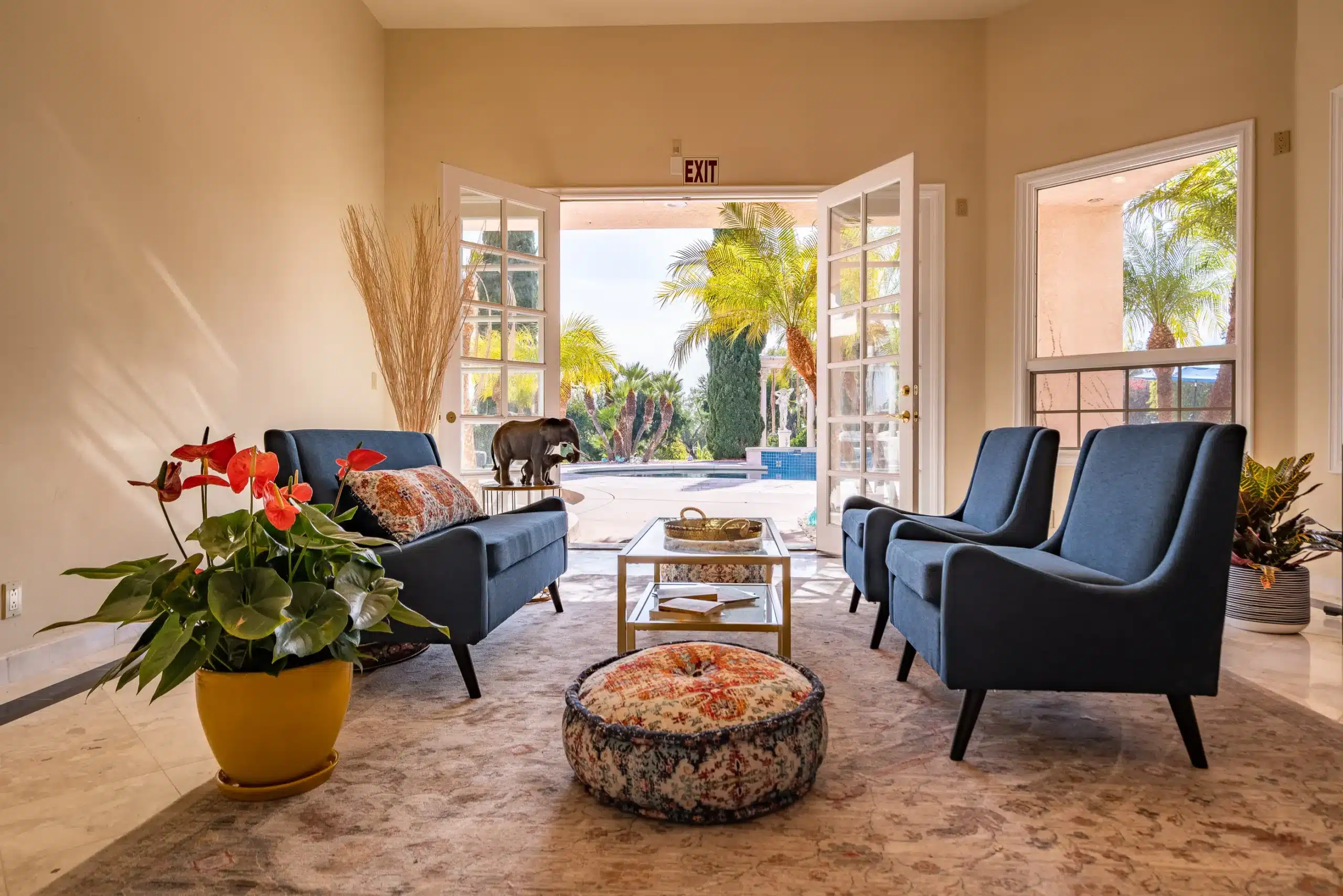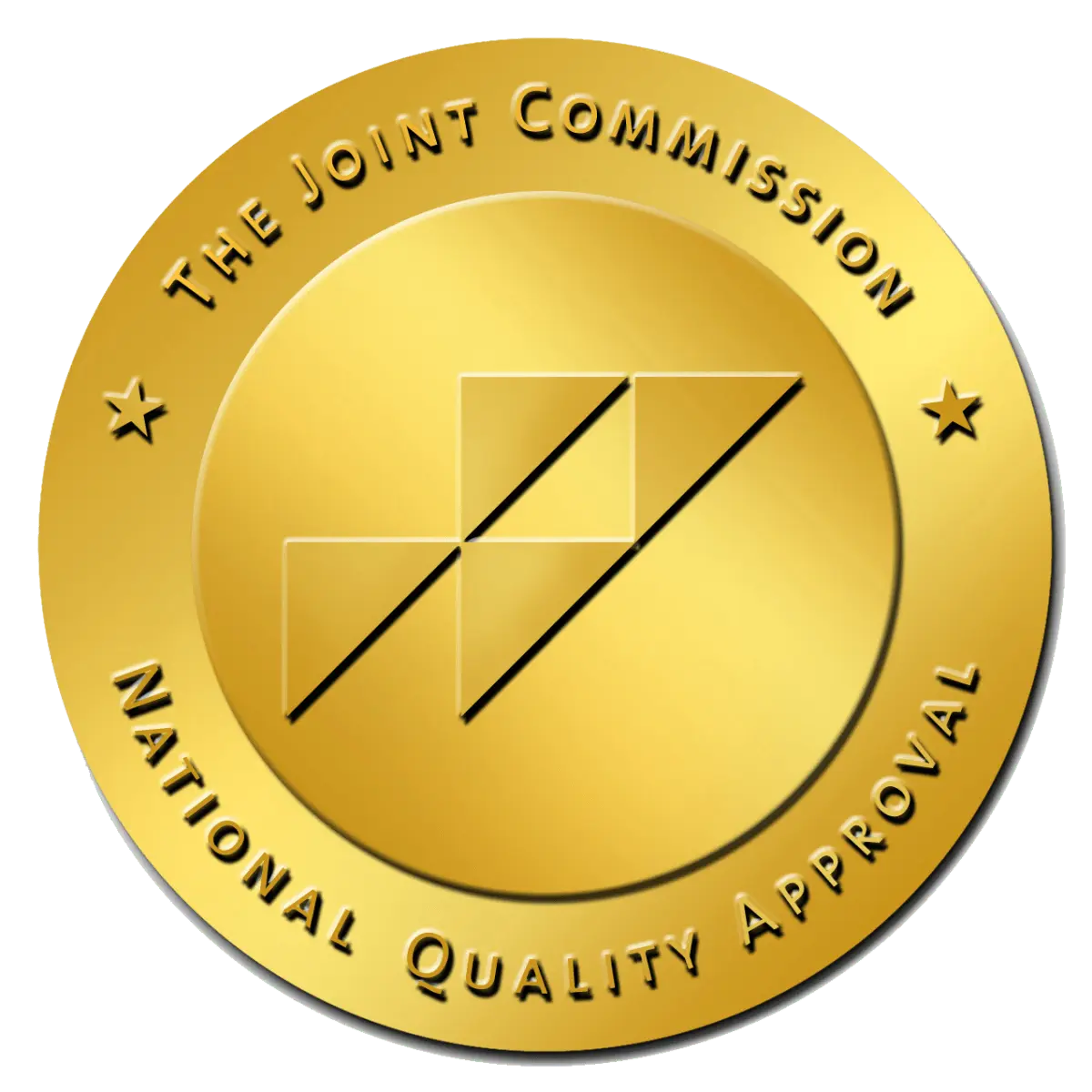ADDICTION TREATMENT IN SAN DIEGO
Written by: Michelle Beaupre, PhD, LCSW | Reviewed by: Christian Small, MD
Villa Oasis offers a comprehensive spectrum of care at our San Diego drug rehab center, tailored to support individuals at every stage of their recovery. Our upscale, luxury residential treatment program blends traditional, evidence-based, and holistic approaches, ensuring a personalized and effective healing experience.
With studies indicating that approximately 8.1% of Americans require treatment for substance use disorders, the need for effective rehabilitation services is undeniable. In San Diego, the prevalent challenges with opioids and street narcotics further stress the necessity for accessible, comprehensive treatment solutions.
At Villa Oasis, we understand the multifaceted nature of addiction and its profound effects. We’re dedicated to offering a complete pathway to recovery, from intensive inpatient care to outpatient treatment and sober living facilities. This ensures a seamless transition through each recovery phase, providing the necessary support for individuals to successfully navigate their journey toward sobriety.
Recognizing the perils of substance abuse, our San Diego center commits to aiding those affected by addiction. Our holistic approach addresses not just the physical toll of addiction but also fosters emotional and psychological healing, laying a foundation for sustained recovery.

LEVELS OF CARE
Detox
Detoxification at Villa Oasis marks the critical first step towards recovery from alcohol, drug addiction, or dual diagnosis with a mental health disorder. Situated in San Diego, Villa Oasis provides an upscale, professionally supported detox and medication-assisted treatment. Our facility is designed to offer comfort and luxury, with a beautiful natural landscape that aids in soothing the detoxification process. The journey to sobriety begins with our detox program, aimed at safely eliminating toxins and chemical substances from the body, reducing the risk of potentially life-threatening withdrawal symptoms. For individuals with physical dependencies, Villa Oasis ensures a secure and essential foundation for the practical path to recovery.

Residential
Considering residential rehab, or inpatient rehab, is a significant step towards recovery for you or a loved one. Villa Oasis offers a detailed guide on what to expect during your stay, providing essential insights into the residential treatment process. Designed for individuals battling substance abuse, including drug and alcohol addiction, our residential program offers a higher level of care and support than outpatient options. This comprehensive and structured approach is especially beneficial for those requiring a supportive and controlled environment to overcome addiction challenges.

Outpatient
Our outpatient rehab program at Villa Oasis includes personalized addiction recovery support, offering a spectrum of care tailored to each individual’s needs. Within this framework, we provide Intensive Outpatient Programs (IOP) and Partial Hospitalization Programs (PHP), designed for adults confronting alcohol or drug addiction in conjunction with mental health disorders. These programs blend the flexibility of outpatient care with the thoroughness of a structured treatment plan, allowing for a more focused and intensive recovery experience without full hospitalization. Our dedicated team collaborates closely with clients to craft customized treatment plans that tackle their unique challenges, ensuring Villa Oasis is a steadfast ally in the journey to long-term recovery.

Sober Living
Villa Oasis understands the challenges of transitioning from intensive treatment to everyday life, emphasizing the importance of a supportive sober living environment for maintaining long-term sobriety. Our sober living homes are more than residences; they’re communities designed to encourage healthy habits and coping strategies. With structured schedules and onsite support, we offer a setting that significantly boosts the chances of sustained recovery. By fostering a network of peers committed to sobriety, Villa Oasis prepares residents for a substance-free future, aiding in rebuilding their lives and ensuring a successful journey toward recovery.

SUBSTANCES WE TREAT
Our facility is equip to handle addictions to alcohol, from detox to residential treatment. We provide those recovering from alcoholism with luxury care.
Cocaine is a common, dangerous substance that our facilities are more than equip to handle. Our cocaine addiction treatment program can help you or a loved one recover from this addiction.
Heroin is a dangerous substance that can cause serious addiction issues. At Villa Oasis, we provide heroin treatment to help people recovery from this debilitating disorder.
Meth is a common substance that affects millions of people each year. Learn how we handle meth addiction treatment at our private facilities.
Stimulants are a deceivingly dangerous substance that affects many people in the United States. Learn about how we treat stimulant addiction at Villa Oasis.
Benzodiazepines are one of two drugs that can be fatal without a proper detox. We’re able to help you or a loved one detox safely during our benzodiazepine addiction treatment program.
Fentanyl is a medically-used substance that can be addictive on its own if taken in larger quantities or outside of a prescription. Learn how we treat fentanyl addiction.
Marijuana is a common drug that often is used in conjunction with other substances. Villa Oasis offers treatment for marijuana addiction and other substances.
Opioids are highly-addictive and highly-dangerous. Our opioid treatment program is one of the best in California.
Our facility is able to handle substance abuse issues for all types of drugs. We believe in an individual approach to substance abuse treatment, and our professional staff aims to make each resident’s journey to recovery lasting and unique.
What is addiction use disorder?
Addiction Use Disorder, also known as Substance Use Disorder, is a severe condition characterized by an individual’s dependence on harmful substances, including alcohol, opioids, or illicit drugs. This dependence stems from changes in the brain’s structure and functioning, leading to altered behavior and an inability to control the substance use, despite the known harmful effects.
In more specific terms, Addiction Use Disorder is recognized when the person’s substance use interferes with their daily life activities, such as maintaining a job, caring for family, or managing personal relationships. This compulsive behavior can also lead to an increase in risk-taking, such as using drugs in dangerous situations or driving under the influence.
The pathway to addiction can start with recreational drug use, which can escalate into drug dependence, particularly for those who engage in frequent substance use. Some substances, like opioids, are notorious for their high addiction rates and severe impacts on an individual’s life.
Substance use disorder may still occur whether a substance is socially accepted, legal, or medically approved. Recreational drug use can lead to drug dependence in individuals who engage in frequent and consistent drug use. Addiction mostly begins with exposure from either a friend or relative using the substance.
Addiction varies by drug. Opioids, for example, have a huge addiction rate compared to other drugs. Additionally, opioids have severe consequences on an individual compared to other drugs. In this regard, discouraging its use is highly recommended, as it saves the individuals great misery in the future.
The more one uses a drug, the more they feel they need it in higher amounts to achieve the pleasurable effect. Unfortunately, the more drugs an individual consumes, the higher the risk of addiction.
As drug consumption increases, abstaining becomes increasingly tricky. Stopping drug use suddenly leads to serious physical and psychological consequences. Some are life-threatening, which, if not addressed, immediately can kill the individual.

How to prevent addiction use disorder?
Preventing Addiction Use Disorder requires a multifaceted approach, incorporating education, community initiatives, family support, and policies discouraging substance use. Prevention begins with awareness and education about the potential risks and harms of substance use. This education should target all age groups but especially focus on young individuals who are at a critical stage in their lives for potential substance exposure.
Moreover, implementing comprehensive drug abuse prevention programs that address the community’s needs, involve all relevant stakeholders, and are backed by scientific research can significantly reduce the prevalence of substance use disorders. These programs should include evidence-based strategies such as family skills training programs that have been shown to be effective in preventing substance abuse in children and adolescents.
Workplace policies against substance use also play an important role in preventing Addiction Use Disorder. These policies help create a safe and healthy working environment and offer support for employees who may be struggling with substance use.
Remember, the goal is to foster a supportive environment that promotes healthy choices and discourages substance use. When prevention efforts are integrated into all aspects of an individual’s life, it becomes possible to create a community resilient to the challenges of Addiction Use Disorder. And when prevention fails, it’s crucial to have effective treatment options available, such as those offered by Villa Oasis San Diego.
Evidence-based family skills training programs are the most effective strategy to prevent substance abuse in children and adolescents. In addition, workplace policies against substance use contribute greatly to preventing substance disorders.
Signs of addiction use disorder
Drug and substance abuse affects psychological and physiological processes in the body. Physical and behavioral changes are among the most visible signs of drug and substance abuse. There are a few indicators that someone is using or abusing drugs. These indicators include:
-
Changes in appearance
▻
-
Bloodshot eyes
▻
-
Glazed eyes
▻
-
Personality change
▻
-
Slurred speech
▻
-
Lack of personal hygeine
▻
-
Tremors
▻
-
Urgent need for money
▻
Encouraging the individual to undergo rehabilitation is highly recommended to prevent worsening the conditions.
Recognizing the harmful & addictive use of substances in the family
Sometimes it is difficult to distinguish between usual teenage mood-swings or anxiety and substance use disorder. Possible signs that a child or another family member is on drugs or other prohibited substances include:
-
They start having problems in school or work. These problems include absenteeism, a sudden loss of interest in their favorite activities or employment, or poor performance in school.
▻
-
They might develop physical health difficulties. These may include lack of energy and motivation, weight loss, stunted growth or an underlying health problem.
▻
-
Neglected appearance: They might become insensitive to their hygiene, grooming, or appearance.
▻
-
They change their personality, especially behavior.
▻
-
They develop an urgent need for money. You may notice unexpected requests for money without a plausible explanation. Or finding that money is missing or stolen or that objects have vanished from your home. They usually sell items they steal to fund their drug use.
▻

When is it time to consider treatment?
Dealing with drug and substance abuse at its onset is the best strategy. Preventing drug addiction is better than curing it. Curing drug addiction is tough, costly, and cumbersome. Here are some indicators that show an individual needs treatment:
Here are some indicators that show an individual needs treatment:
-
They have an extremely high tolerance to the drug.
▻
-
They need medication to manage tension or anxiety.
▻
-
They have lost interest in the things they formerly cherished or enjoyed.
▻
-
Their mental or physical health is deteriorating.
▻
-
They undergo distinct mood shifts.
▻
-
Their withdrawal symptoms induce a desire to use drugs again.
▻
-
Their significant relationships are adversely affected, especially in marriages and their association with their children.
▻
-
They are untruthful regarding their substance misuse and financial issues.
▻
-
They have attempted to quit on their own but are unable to.
▻
How to help someone going through addiction
It is tough to assist a person battling drug and substance addiction. Always consider that it is hard to control a person’s substance use or force them to stop. This is especially true if they are addicts.
The best way to help them is to provide them with psychosocial support. This can be done by encouraging them to seek treatment or visit a self-help meeting. If your friend or family member worries that treatment will not be effective, reassure them.
Rehab treatment to help individuals quit drug and substance abuse is effective. Point out that the treatment is required to heal brain damage caused by and be worsened by compulsive and recurrent substance use.
Treatment options
There are numerous effective ways to treat drug addiction, which involves a comprehensive approach that promotes overall wellness. Here are a selection of effective treatment services that are key in the journey to addiction recovery:
-
Behavioral counseling
▻
-
Medications
▻
-
Medical equipment and applications used to relieve withdrawal symptoms or teach skills
▻
-
Therapy for concurrent mental health conditions, such as depression and anxiety
▻
-
Prevention of relapse through follow up
▻

Addiction treatment in San Diego, CA with Villa Oasis
Villa Oasis San Diego is a drug and alcohol addiction treatment clinic that offers individualized, holistic programs. These programs aid in long-term recovery from alcohol or drug abuse. Our objective is to address substance dependence and the mental and emotional reasons for addiction.
If you are suffering from substance use disorder, our staff is qualified to assist you. Several members have been in your position and recovered. We use trusted techniques as a part of our substance abuse treatment program.
Contact us for any inquiries on drug and substance addiction treatment programs.
Frequently Asked Questions
We treats both drug and alcohol addiction, offering comprehensive residential rehab treatment to support individuals on their path to recovery.
Residential treatment is designed for individuals struggling with substance abuse who require a higher level of care and support than outpatient programs provide. This includes those with a history of chronic relapse, severe or long-term addiction, withdrawal symptoms or cravings, co-occurring mental health disorders, and alcohol-related interpersonal conflicts.
We offers a comprehensive range of evidence-based therapies, including dual diagnosis treatment, individual and group therapy, 12-step and non-12-step programs, cognitive-behavioral therapy (CBT), dialectical behavior therapy (DBT), mindfulness and meditation, art, music, and equine therapy, and nutritional counseling and fitness programs.
Yes, we provide medically supervised detox services for clients who require detoxification from drugs or alcohol. The medical professionals closely monitor clients during the detox process, ensuring their safety and comfort while managing withdrawal symptoms.
Upon contacting Villa Oasis, the admissions team will guide you through the initial assessment process to determine the appropriate level of care and create a personalized treatment plan. This process may include a review of medical and mental health history, as well as an evaluation of the individual’s current substance use and support system.




